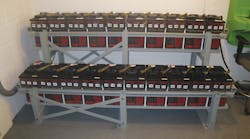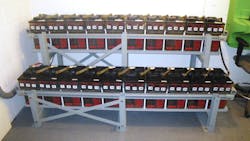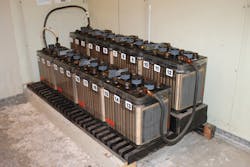Purchasing, sizing, maintaining and testing batteries is key to power reliability in a substation. Here are a few questions on how to properly do all of that.
What happens when a battery bank fails?
The heart of a substation is the battery bank. If this were to fail, this is what could happen:
- An electric utility could expose all feeders associated with the station to a condition where they could not ever trip in a fault.
- Any backup devices, such as the main breaker on the low-voltage side or the high-voltage side protection of the power transformer, would all be inoperative.
What would happen if you only had the transmission grid protection as a backup?
A fault on the low-voltage side of a Delta Wye transformer, especially a phase-to-ground fault, could convert to a phase-to-phase fault on the high side. This could likely happen if the fault is located a few miles away from the substation.
Then, a utility could face the following catastrophic consequences:
Wire could burn down across a town.
↓
The substation transformer could be completely destroyed.
↓
After the smoke clears, much of the substation could be heavily damaged and the power transformer could be in flames.
↓
It could cause hazards to the public.
What are some do’s and don’ts when it comes to purchasing substation batteries?
- Don’t skimp on your battery purchase. Instead, carefully think about what kinds of batteries you need to buy and install at your substation.
- Do determine your maximum load. Since substation devices normally trip in milliseconds, and the 1-minute rate of the size of batteries far exceeds what you need, this is usually not the deciding rating.
- Don’t forget to pay attention to devices with a large draw. If you have bus clearing schemes that will operate many devices simultaneously and circuit switchers are involved, you may have a larger draw than expected.
- Do figure out how long you want to operate the substation in an outage condition. Plan for a minimum of 24 hours. That way, if there is a system-wide event where resources are spread thin, you can monitor the station on supervisory control and data acquisition (SCADA) for 24 hours. You can also close and open devices if needed. Then, in the event that the power will not be coming back on in the area, you can either shut down the DC or set up a portable generator at the substation.
How do you properly size the substation batteries?
- Consider your entire continuous load. The load should include SCADA, lights, computers, pumps and control relays. Once you have this current, you can calculate the amp-hour capacity you need to buy.
- Know the rating for lead-acid and NiCad batteries. Typically, lead-acid batteries are rated at the 8-hour rate and NiCad batteries are rated at a 5-hour rate.
- Determine the end-of-life for lead-acid batteries. For lead-acid batteries, a battery has reached its end of life when it only has 80% capacity left. As such, you need to figure on 80% of purchased capacity if you intend to run these all the way to the end of life.
- How do you figure this out? The slower you discharge the battery, the more capacity it has in amp-hours. Therefore, if the battery has a published 8-hour rate of 100 AH and there is not a longer rate given, the 24-hour rate will contain at least as much energy as the 8-hour rate. Here is how to solve the mathematical equation:-Eighty percent of 100 AH is 80 AH. -Divide this by 24 giving 3.33 A. This would be the draw you could have for 24 hours. -The battery is considered discharged at 1.75 V per cell or for a 48-V bank is 42 V. The above battery would hit this 42 V in 24 hours with 3.33 A draw at end of life.
- Doublecheck the data. Always check published data because the manufacturer may have some discharge rates for longer times than eight hours.
What are the five steps to proper battery maintenance?
Step 1: Every month, perform an inspection. Check the electrolyte level and the float voltage of each cell and the bank float voltage. Don’t add distilled water until they get at least halfway down in the level operating zone.
Step 2: Equalize the batteries. After you add distilled water, equalize it for at least 48 hours or until all cells are gassing vigorously to mix the newly added water with the electrolyte.
Step 3: Make adjustments. If the voltage between cells gets too far off per the manufacturer’s recommendations, you can equalize the batteries for at least 48 hours to try to bring them back in line. You can also take a specific gravity reading of a pilot cell, which will tell you the state of charge. This is normally okay if you have the float and equalize voltages set correctly.
Step 4: Ensure that the battery bank is not grounded at either end. It should float with both ends above the ground. You can conduct this test easily with a voltmeter. Some chargers will give an alarm when this occurs.
When should you consider replacement?
Batteries are so crucial to the overall reliability of the substation. If you’ve gotten 20 to 25 years of life out of the batteries, and they are reaching 80% to 90% of capacity, think about replacing them. It’s not worth trying to squeeze the last bit of life out of substation batteries.
What are two ways you can monitor the batteries 24/7?
When it comes to substation batteries, you can’t take the chance of them going dead due to a charger failure. To prevent this from happening, make sure you keep the batteries clean and the connections clean and greased. Also, you can:
- Install SCADA at your substation.
- Implement cell phone monitoring similar to what you would have on your house as a monitored security system. With this approach, you will be notified if the charger fails so you can get ahead of the problem.
What are four things you should keep in mind when it comes to DC?
- DC is much harder to interrupt than AC because you never cross a current zero.
- The breakers in the DC panel must be rated for DC.
- The rule of thumb for fault current of lead-acid batteries can be about 12 times the 1-minute rate. It’s even higher for NiCad.
- Check with the manufacturer to get the available fault current and make sure the DC breakers have adequate AIC.
Why should you not use a main breaker in your DC panel?
Batteries provide energy for your power circuit breakers to trip off faults. Here’s what happens if a power circuit breaker fails.
- An upstream power circuit breaker will back it up, but only if the upstream power circuit breaker has DC.
- If you use a main breaker on the DC panel, and for some reason that main breaker trips, you have no battery at the station, and you have no back up.
Look at what you have to lose and what you have to gain by using a main breaker in the DC panel, and it’s a no brainer. Rather than using a main breaker in your DC panel, instead order your batteries with main lugs only.
What are some other best practices when it comes to connecting loads to the batteries?
- Run conductors from the battery to the panel direct with no splices, no disconnects, but rather just extra flexible, CU, THHN, 600V insulated wire.
- Consider using a single two-pole DC breaker per control panel.
- Other than that single breaker, you can slug any other protective devices in this DC path including the DC fuses in the power circuit breaker. That way, there is no risk of a tired fuse letting go and causing it not to trip when needed.
- As a last way to confirm that one DC breaker is not tripped, you can monitor it with SCADA. You can also use SCADA to monitor the trip coil circuit. With this plan, hopefully you will never experience a situation where you can’t trip when called on.
What is the difference between the old and new ways of installing battery banks in substations?
Then: This old C&D lead calcium bank lacks a proper earthquake-rated rack.
Now: This 48V bank features lead-calcium batteries, which have an anticipated life span of 20 years and a relatively low float current.
Who can I contact for more information about substation batteries?
The author of this article, Gary Wright, consults for McMinnville Water & Light and Forest Grove Light & Power in Oregon. He started out in the power industry in 1977, and first worked at Cowlitz County PUD in substation design and distribution system planning. He can be reached at [email protected].




